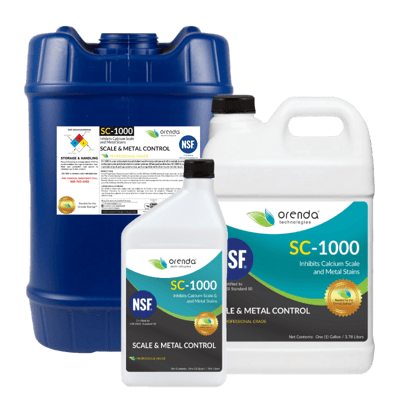How long after purging with SC-1000 will a pool be able to hold chlorine?
The SC-1000 purge dose depletes chlorine for a few days while it finds metals and minerals to chelate.
Related: How to accelerate chlorine recovery after purging with SC-1000
It usually takes 3-4 days before being able to hold a free chlorine level after purging with SC-1000. The length of time depends on:
- the water temperature,
- the amount of metals/minerals in the water,
- the pool's circulation/turnover rate, and
- the amount of SC-1000 added.
Water temperature
The warmer the water, the better and faster SC-1000 does its job. Cold water slows chemistry down, and SC-1000 is no different. Chelation takes time. Water below 70ºF can take a week or more to hold chlorine again. Water about 75-80ºF should take 3-4 days. Water over 80ºF generally takes 2-3 days.
This, of course, can be accelerated if you are adding calcium chloride to the pool. If so, pre-chelate the calcium chloride by adding the SC-1000 to the bucket (or Orenda Startup Barrel™) with dissolving calcium chloride. The heat from dissolving calcium activates SC-1000, and accelerates it doing its job in the water.
You can also turn on your pool heater to accelerate SC-1000 chelation.
Amount of metals/minerals in the water
If there are high levels of metals in the water, SC-1000 has plenty to do, and it will do its job relatively quickly. Higher levels of calcium hardness also help.
Pool circulation/turnover rate
The better the circulation, the faster SC-1000 can spread and do its job. This translates to less time before holding chlorine again.
The amount of SC-1000 added
You might be surprised, but one of the more common issues we hear about is people overdosing SC-1000. Don't do that. Follow the dosing in the Orenda app, and follow the instructions on how to use SC-1000. With the exception of a startup, rounding up on SC-1000 just means more time before holding chlorine again.
One thing we recommend is dividing up the purge dose of SC-1000 into multiple visits. Maybe do 1/3 or 1/4 of the dose at a time, separated by a few days. Getting SC-1000 into the pool is not a race (except on a startup, when it needs to all be added as the pool is filling).
Why does SC-1000 wipe out free chlorine?
We cover this question more in-depth in another article. In oversimplified terms, SC-1000 is immune to chlorine oxidation, but chlorine does not know what SC-1000 is. So chlorine tries to oxidize SC-1000 (and fails), and it gets reduced. In other words, chlorine is wiped out quickly because it gets used up trying to oxidize SC-1000.
SC-1000 will eventually chelate metals and minerals, which changes its valence so that chlorine no longer tries to oxidize it. Chlorine and chelated metals live in harmony at that point.
